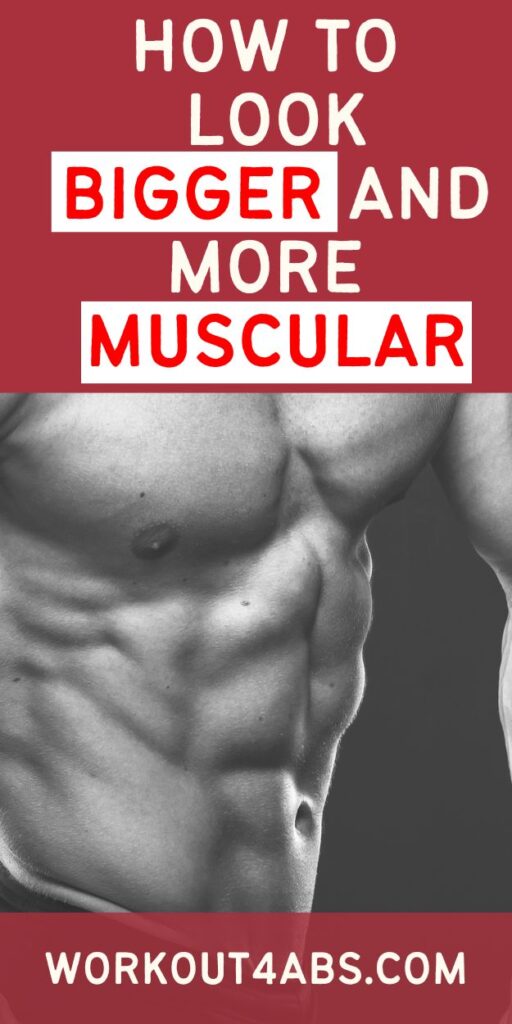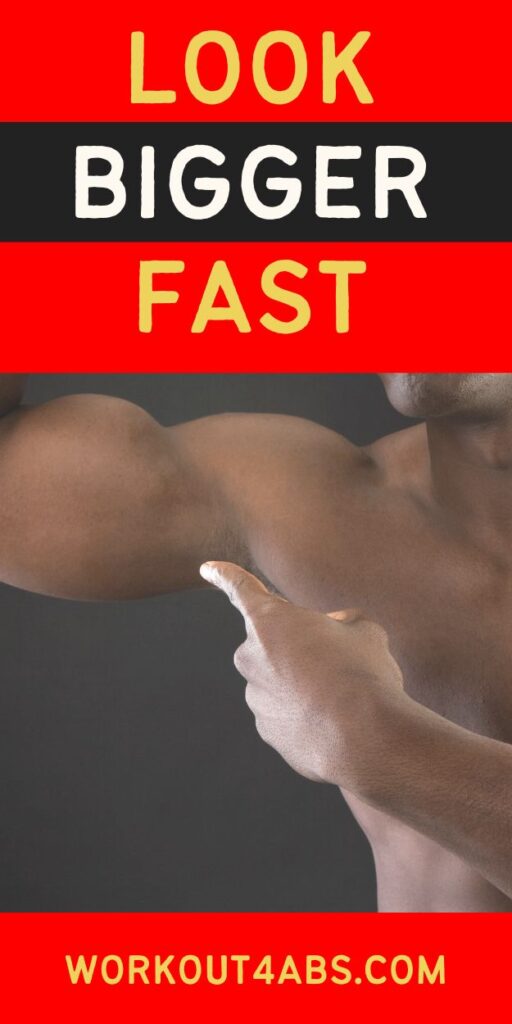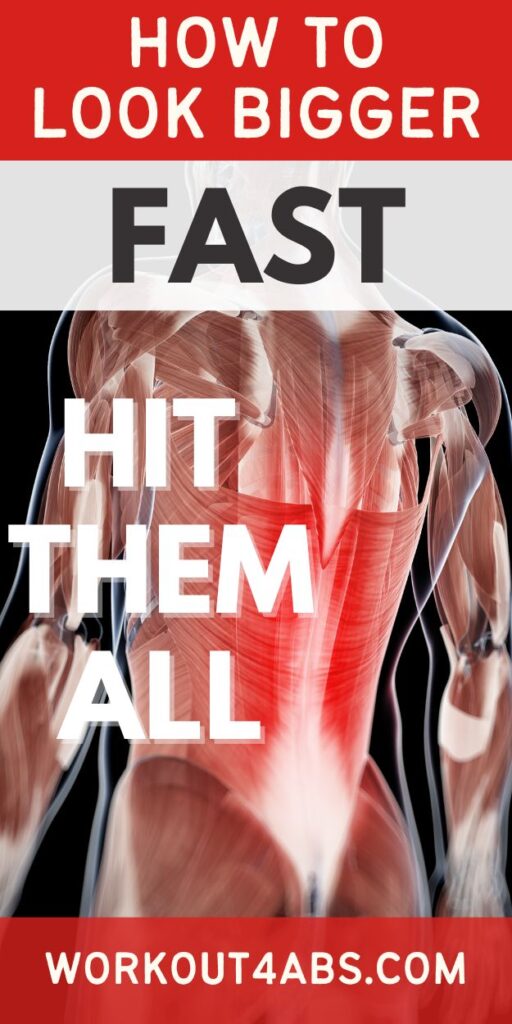Would you like to know how to look bigger and more muscular? Discover the path to a more muscular you with 5 straightforward strategies. From cultivating broader shoulders to adopting bodybuilder-inspired training, optimizing carbohydrate intake, and maintaining an ideal body fat percentage, these tips can transform your physique and boost your confidence in no time.
If you enjoyed these tips, please save this pin to your Pinterest Board.

Build Broad Shoulders
Building broader shoulders can enhance your overall upper body aesthetics and strength. Here are five tips to help you achieve this goal:
- Prioritize Overhead Pressing: Incorporate compound movements like the overhead press, whether it’s a barbell, dumbbell, or machine variation. This exercise targets the deltoid muscles and helps in developing both the front and side portions of your shoulders.
- Include Lateral Raises: Lateral raises are excellent for targeting the side (lateral) deltoids, which contribute to broader-looking shoulders. Use proper form, and gradually increase weights as you progress to challenge your muscles.
- Work on Rear Delts: Neglecting the rear deltoids can create an imbalance. Include exercises like face pulls, bent-over lateral raises, and reverse pec deck to develop the posterior (rear) deltoids for a well-rounded shoulder appearance.
- Vary Grips and Angles: Incorporate different grips and angles in your exercises. Wide-grip pull-ups and rows can engage the upper back, contributing to broader shoulders. Changing angles in exercises like lateral raises can target specific parts of the deltoids.
- Maintain Proper Nutrition and Rest: A balanced diet rich in protein supports muscle growth. Prioritize lean proteins, whole grains, and plenty of fruits and vegetables. Ensure adequate sleep and recovery time to allow your muscles to repair and grow.
Remember that consistency, proper form, and gradual progression are essential. Consult a fitness professional or trainer to customize your workout routine and ensure that you’re performing exercises correctly to avoid injury.
The three exercises I recommend for broader shoulders.
#1 Dumbbell Shoulder Press
Dumbbell Shoulder Press:
1. Set Up:
- Start by selecting a pair of dumbbells that you can comfortably lift for your chosen number of repetitions.
- Sit on a bench with back support that has an adjustable backrest or use a sturdy, upright bench.
2. Bench Position:
- Adjust the bench to an upright position (90-degree angle) or a slight incline, depending on your preference and comfort.
3. Starting Position:
- Hold a dumbbell in each hand at shoulder height with an overhand grip (palms facing forward) and your elbows bent.
- Your wrists should be aligned with your forearms, and your upper arms should be parallel to the ground.
4. Pressing Motion:
- Inhale and push the dumbbells upward by extending your arms while keeping your wrists and elbows aligned.
- As you press, your dumbbells should meet or almost touch at the top, but don’t forcefully slam them together.
5. Full Extension:
- Fully extend your arms without locking out your elbows at the top of the movement. Your palms should be facing forward, and your biceps should be close to your ears.
6. Lowering Phase:
- Exhale and gradually lower the dumbbells back to shoulder height while maintaining control.
- Keep your core engaged and avoid using momentum to lift the weights.
7. Repeat:
- Perform the desired number of repetitions for your set. Focus on a controlled and smooth movement throughout.
8. Cool Down:
- After completing your sets, gently stretch your shoulder muscles to help relax them.
Tips:
- Keep your back flat against the bench and your feet flat on the floor for stability.
- Engage your core muscles to support your lower back and maintain proper posture.
- Avoid arching your back or leaning excessively during the lift.
- Choose a weight that challenges you but allows you to maintain proper form.
- Focus on a controlled pace both during the lifting and lowering phases.
- If you’re new to this exercise, start with a lighter weight to master the movement before increasing the load.
The dumbbell shoulder press is an effective exercise for targeting the shoulder muscles, particularly the front (anterior) deltoids. If you’re unsure about your form or technique, consider working with a fitness professional or a knowledgeable trainer to ensure you’re performing the exercise correctly.
#2 Lateral Raises
The dumbbell lateral raise is an excellent exercise for targeting the side (lateral) deltoid muscles, helping to build broader shoulders. Here’s a step-by-step guide on how to perform it:
Dumbbell Lateral Raise:
1. Set Up:
- Begin by selecting a pair of dumbbells with an appropriate weight for your fitness level.
- Stand up straight with your feet shoulder-width apart. Hold a dumbbell in each hand by your sides, with your palms facing your body.
2. Starting Position:
- Keep your back straight, chest up, and core engaged for stability.
- Position the dumbbells in front of your thighs, and your arms should be fully extended.
3. Lifting Motion:
- Inhale and, with a slight bend in your elbows, raise the dumbbells directly to your sides. Keep your arms straight but not locked.
- Lift the weights until they are at shoulder level or just slightly below. Imagine you’re pouring water out of two pitchers.
4. Squeeze and Hold:
- At the top of the movement, pause for a moment and contract your side deltoid muscles. This maximizes the tension on the shoulders.
5. Lowering Phase:
- Exhale and slowly lower the dumbbells back to the starting position, maintaining control throughout the descent.
- Avoid letting the weights swing or using momentum to lift them.
6. Repeat:
- Perform the desired number of repetitions. Typically, 3 sets of 10-15 reps work well for building shoulder definition and strength.
7. Cool Down:
- After completing your sets, gently stretch your shoulder muscles to relax them.
Tips:
- Use a weight that allows you to perform the exercise with proper form and control.
- Focus on maintaining a slight bend in your elbows throughout the movement; avoid locking them.
- Keep your core engaged to stabilize your body.
- Control the weights both on the way up and on the way down to maximize the effectiveness of the exercise.
- Don’t lift the weights too high or shrug your shoulders; this can put unnecessary stress on your neck and traps.
Dumbbell lateral raises can help isolate the side deltoid muscles, which contribute to a broader and more defined shoulder appearance. As with any exercise, it’s important to use proper form and start with a weight that’s manageable to prevent injury and ensure effective results.
#3 Reverse Fly’s
The reverse fly, also known as the reverse dumbbell fly or rear delt fly, is an effective exercise for targeting the rear deltoid muscles and upper back. Here’s a step-by-step guide on how to perform it:
Reverse Fly Exercise:
1. Set Up:
- Begin by selecting a pair of dumbbells with an appropriate weight for your fitness level.
- Stand up straight with your feet hip-width apart. Hold a dumbbell in each hand with an overhand grip (palms facing in) and let your arms hang in front of you.
2. Starting Position:
- Keep your back straight, chest up, and core engaged for stability.
- Slightly bend your knees and hinge at your hips, leaning your torso forward to about a 45-degree angle. Your upper body should be almost parallel to the floor.
3. Lifting Motion:
- Inhale and, with a slight bend in your elbows, lift the dumbbells to your sides. Imagine you’re spreading your wings.
- As you lift, keep your arms almost parallel to the ground. Your hands should be slightly higher than your elbows.
4. Squeeze and Hold:
- At the top of the movement, pause for a moment and squeeze your rear deltoid muscles. This maximizes the tension on the targeted muscles.
5. Lowering Phase:
- Exhale and slowly lower the dumbbells back to the starting position, maintaining control throughout the descent.
6. Repeat:
- Perform the desired number of repetitions. Aim for 3 sets of 10-15 reps to effectively engage your rear deltoids and upper back.
7. Cool Down:
- After completing your sets, gently stretch your shoulder and upper back muscles to relax them.
Tips:
- Choose a weight that allows you to maintain proper form and control.
- Keep your arms slightly bent at the elbows throughout the movement, avoiding fully locked elbows.
- Focus on squeezing your rear deltoids and upper back muscles at the top of the movement.
- Keep your neck in a neutral position, looking down slightly to maintain alignment with your spine.
- Avoid using momentum to lift the weights; control the movement throughout.
- If you have any shoulder or back issues, start with lighter weights and focus on maintaining good form.
Reverse fly exercises help balance out shoulder development, targeting the often-neglected rear deltoid muscles. As with any exercise, proper form is essential to prevent injury and achieve the best results. If you’re unsure about your technique, consider seeking guidance from a fitness professional or trainer.
If you enjoyed these tips, please save this pin to your Pinterest Board.

Train Like a Bodybuilder
Keeping the repetition range between 6 to 15 is a widely recommended strategy for building muscle, and it’s often referred to as the hypertrophy range. Here’s why this range is effective for muscle growth:
1. Muscle Fiber Activation:
- Lower rep ranges (around 6 repetitions) with heavier weights primarily stimulate the activation of fast-twitch muscle fibers. These fibers have a high potential for growth and strength development.
- Higher rep ranges (around 15 repetitions) target slow-twitch muscle fibers. While they have less growth potential than fast-twitch fibers, they play a crucial role in endurance and recovery.
- By including a range of repetitions, you engage both muscle fiber types, promoting comprehensive muscle development.
2. Mechanical Tension:
- Lifting heavier weights in the lower rep range places significant mechanical tension on muscles. This tension is a key driver of muscle growth as it creates micro-tears in muscle fibers, leading to repair and growth during recovery.
3. Metabolic Stress:
- Performing higher repetitions with moderate weights creates metabolic stress within muscles. This stress increases the production of metabolites, like lactic acid, which contribute to muscle growth by triggering hormonal responses and promoting nutrient delivery.
4. Time Under Tension:
- The time your muscles spend under tension during a set contributes to muscle growth. Moderate rep ranges allow for a balanced combination of time under tension and adequate load, promoting both strength and hypertrophy.
5. Variation and Progression:
- Incorporating different rep ranges adds variety to your workouts, preventing plateaus and overuse injuries.
- Adjusting the weight and rep range over time allows for progressive overload, which is crucial for consistent muscle growth.
6. Individual Differences:
- People respond differently to various rep ranges due to factors like genetics, training history, and muscle fiber composition.
- The 6 to 15 rep range provides a balance that works well for many individuals and allows room for customization based on individual preferences.
Remember that training for muscle growth should involve a combination of rep ranges, adequate nutrition, recovery, and progressive overload. Additionally, consult a fitness professional or trainer to develop a workout plan that aligns with your fitness goals and abilities.
If you enjoyed these tips, please save this pin to your Pinterest Board.

Get Lean, Not Shredded
Keeping your body fat percentage within the range of 10% to 15% can indeed contribute to a more muscular and visually impressive physique. Striving to get too lean, below this range, can have negative effects on your appearance and overall well-being. Here’s why:
1. Muscle Definition:
- Maintaining a body fat percentage between 10% and 15% allows your muscles to be more visible, enhancing the appearance of size and definition. Lower body fat levels expose muscle striations and separation, giving a more chiseled look.
2. Muscle Fullness:
- A slightly higher body fat percentage can contribute to muscle fullness, making muscles look more rounded and larger. Adequate body fat levels provide a layer of cushioning under the skin, enhancing the appearance of muscle volume.
3. Hormonal Balance:
- Extremely low body fat levels can disrupt hormonal balance, including testosterone and cortisol. This can lead to muscle loss, decreased energy, and even negative impacts on mood and libido.
4. Energy Levels and Recovery:
- Maintaining body fat within the 10% to 15% range provides a buffer of stored energy, which is essential for optimal training performance and recovery. Very low body fat can lead to decreased energy levels, hampering your workouts and recovery process.
5. Sustainable Lifestyle:
- Staying extremely lean year-round can be challenging and may lead to obsessive behaviors, impacting your mental and emotional well-being. It’s important to find a sustainable lifestyle that balances fitness goals and overall health.
6. Aesthetic Balance:
- Building muscle is a gradual process, and having a slightly higher body fat percentage helps create a well-rounded aesthetic balance. It can make you look healthier and more proportionate.
7. Individual Factors:
- Everyone’s body responds differently to various body fat levels. Genetic factors play a role in how your body composition appears, and trying to force an extremely low body fat percentage might not align with your natural tendencies.
8. Avoiding the “Skinny” Look:
- If you aim for extremely low body fat levels, there’s a risk of appearing “skinny” rather than muscular, as muscle definition might not be as prominent without a moderate amount of body fat.
Remember, the goal is to achieve a balanced and healthy physique. Balancing muscle gain with a reasonable body fat percentage not only helps you look more muscular but also contributes to your overall well-being. Always prioritize your health, sustainability, and personal preferences in your fitness journey. Consulting with a fitness professional or registered dietitian can help you develop a sustainable plan that aligns with your goals.
Load Up the Carbs
Consuming an ample amount of carbohydrates is a key aspect of building muscle and achieving a fuller, more muscular appearance. Carbohydrates play a crucial role in fueling your workouts, replenishing glycogen stores, and supporting muscle growth. Here’s how:
1. Fuel for Workouts:
- Carbohydrates are your body’s primary energy source. When you consume carbohydrates, they are broken down into glucose, which your muscles and brain use for energy. Having sufficient energy during your workouts enables you to lift heavier weights and perform more reps, stimulating muscle growth.
2. Glycogen Replenishment:
- Glycogen is the stored form of glucose in your muscles and liver. Intense exercise depletes glycogen stores. After a workout, consuming carbohydrates helps replenish these stores, which are essential for muscle endurance and strength in subsequent workouts.
3. Muscle Fullness and Appearance:
- Carbohydrates also contribute to muscle fullness. When glycogen stores are full, muscles appear rounder and more defined. This fullness can enhance the visual appearance of muscle size and overall physique.
4. Protein Sparing:
- Adequate carbohydrate intake helps spare dietary protein from being used as an energy source. Protein is crucial for repairing and building muscles. When carbohydrates provide energy, protein can focus on its primary role: supporting muscle growth and repair.
5. Anabolic Hormones:
- Carbohydrates have an impact on insulin, an anabolic hormone. Insulin helps shuttle nutrients, including amino acids (building blocks of protein), into muscle cells, facilitating muscle growth and recovery.
6. Recovery and Muscle Protein Synthesis:
- Carbohydrates play a role in the post-workout recovery process. Consuming carbs along with protein after a workout promotes muscle protein synthesis, the process through which muscles repair and grow.
7. Performance Improvement:
- Consuming carbs before and during workouts can enhance your performance. They provide sustained energy, helping you train harder, lift heavier, and optimize muscle-building potential.
8. Individual Needs:
- The amount of carbohydrates needed varies based on factors such as your body size, activity level, metabolism, and fitness goals. Tailoring carbohydrate intake to your individual needs is essential for achieving the desired effects.
It’s important to note that while carbohydrates are beneficial, the quality of carbs matters. Opt for complex carbohydrates like whole grains, fruits, vegetables, and legumes, as they provide sustained energy and essential nutrients. Balancing carbohydrate intake with protein and healthy fats is crucial for overall nutrition and achieving your fitness goals.
Always consult with a registered dietitian or nutrition professional to create a nutrition plan that suits your individual needs and supports your muscle-building goals.
Home › Aesthetic Body Plan ›How to Look Bigger